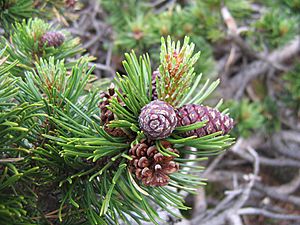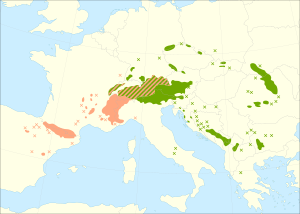Pinus mugo facts for kids
Quick facts for kids Pinus mugo |
|
|---|---|
 |
|
| Conservation status | |
| Scientific classification | |
| Genus: |
Pinus
|
| Species: |
mugo
|
| Subspecies, cultivars, and forms | |
|
List
P. mugo subsp. mugo Turra - Dwarf mountain pine
P. mugo subsp. rotunda Janch. & H. Neumayer P. mugo subsp. uncinata (Ramond) Domin - Mountain pine P. mugo nothosubsp. rotundata Janch. & H. Neumayer P. mugo f. mughoides (Willk.) K.I.Chr. P. mugo Compacta P. mugo Frisia P. mugo Gnom P. mugo Hesse P. mugo Kobold P. mugo Kokarde P. mugo Mops P. mugo Pumilio P. mugo Slavinii P. mugo Variegata P. mugo Virgata |
|
 |
|
Distribution map:
|
|
| Synonyms | |
|
List
Pinus × obliqua var. centrapedunculata Woerl.
Pinus applanata (Booth ex Loudon) Willk. Pinus digenea Wettst. nom. illeg. Pinus echinata Carrière nom. inval. Pinus fischeri Booth ex P.Laws. nom. illeg. Pinus magellensis Schouw Pinus montana Mill. Pinus mugho Laichard. [Spelling variant] Pinus mughus Scop. Pinus obliqua var. centrapedunculata Woerl. Pinus pumilio (Haenke in Jirazek et al) Franco Pinus pumilio Haenke Pinus rostrata K.Koch nom. inval. Pinus rubriflora Loudon ex Gordon nom. inval. Pinus sanguinea Lapeyr. Pinus squamosa Bosc ex Loudon Pinus sylvestris var. montana (Mill.) Aiton Pinus sylvestris var. montana (Mill.) Dum. Cours. Pinus sylvestris var. montana (Mill.) Wahlenb. Pinus sylvestris var. palustris Hagenb. Pinus sylvestris var. pumilio (Haenke) Gaudin Pinus wettsteinii Fritsch |
|
Pinus mugo, known as bog pine, creeping pine, dwarf mountain pine, mugo pine, mountain pine, scrub mountain pine, or Swiss mountain pine, is a species of conifer, native to high elevation habitats from southwestern to Central Europe and Southeast Europe.
Description
The tree has dark green leaves ("needles") in pairs, 3–7 centimetres (1+1⁄4–2+3⁄4 inches) long.
The cones are nut-brown, 2.5–5.5 cm (1–2+1⁄8 in) long.
Taxonomy
There are three subspecies:
- Pinus mugo subsp. mugo — in the east and south of the range (southern & eastern Alps, Balkan Peninsula), a low, shrubby, often multi-stemmed plant to 3–6 metres (10–20 feet) tall with matte-textured symmetrical cones, which are thin-scaled.
- Pinus mugo subsp. uncinata — in the west and north of the range (from the Pyrenees northeast to Poland), a larger, usually single-stemmed tree to 20 m (66 ft) tall with glossy-textured asymmetrical cones, the scales of which are much thicker on the upper side.
Some botanists treat the western subspecies as a separate species, Pinus uncinata, others as only a variety, P. mugo var. rostrata. This subspecies in the Pyrenees marks the alpine tree line or timberline, the edge of the habitat at which trees are capable of growing. - Pinus mugo subsp. rotundata — hybrid subspecies, of the two subspecies above that intergrade extensively in the western Alps and northern Carpathians.
An old name for the species, Pinus montana, is still occasionally seen, and a typographical error "mugho" (first made in a prominent 18th-century encyclopedia) is still often repeated.
Distribution
Pinus mugo is native to the subalpine zones of the Pyrenees, Alps, Erzgebirge, Carpathians, northern and central Apennines, and higher Balkan Peninsula mountains – Rila, Pirin, Korab, Accursed Mountains, etc. It is usually found from 1,000–2,200 m (3,281–7,218 ft), occasionally as low as 200 m (656 ft) in the north of the range in Germany and Poland, and as high as 2,700 m (8,858 ft) in the south of the range in Bulgaria and the Pyrenees. Also in Kosovo it is found in the Bjeshkët e Nemuna National Park.
In Scandinavia, Finland and the Baltic region, P. mugo was introduced in the late 1700s and the 1800s, when it was planted in coastal regions for sand dune stabilization, and later as ornamental plants around residences. In Denmark, Norway and Sweden, the species has naturalised and become invasive, displacing fragile dune and dune heath habitats. In Estonia and Lithuania P. mugo only occasionally naturalises outside plantations, sometimes establishing in raised bogs.
Ecology
Pinus mugo is classed as a wilding conifer, and spreads as an invasive species in the high country of New Zealand, coastal Denmark, and other areas of Scandinavia.
Cultivation
Pinus mugo is widely cultivated as an ornamental plant, for use as a small tree or shrub, planted in gardens and in larger pots and planters. It is also used in Japanese garden style landscapes, and for larger bonsai specimens. In Kosovo, its trunk is used as construction material for the vernacular architecture in the mountains called "Bosonica".
Cultivars
Numerous cultivars have been selected. The following have been given the Royal Horticultural Society’s Award of Garden Merit:
- ’Humpy’
- 'Kissen'
- ’Mops’
- ’Ophir’
Cultivars with seasonal changes in foliage color include Pinus mugo 'Wintergold' and Pinus mugo 'Ophir'.
Uses
A recent trend is the increase in use of the mugo pine in cooking. Buds and young cones are harvested from the wild in the spring and left to dry in the sun over the summer and into autumn. The cones and buds gradually drip syrup, which is then boiled down to a concentrate and combined with sugar to make pine syrup. The syrup is usually sold as "pinecone syrup" or "pine cone syrup".
Gallery
-
Male pollen producing strobili
See also
 In Spanish: Pinus mugo para niños
In Spanish: Pinus mugo para niños










